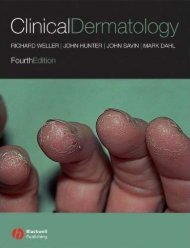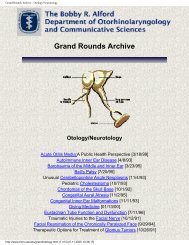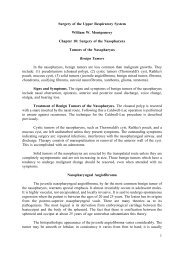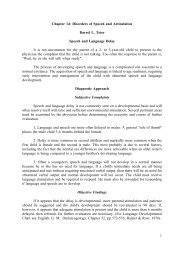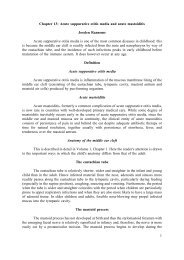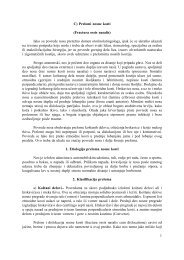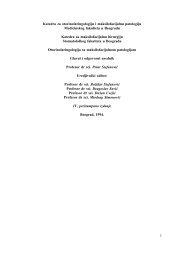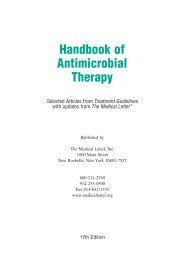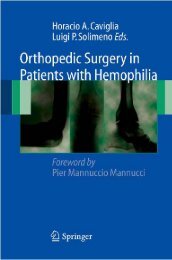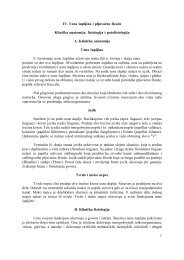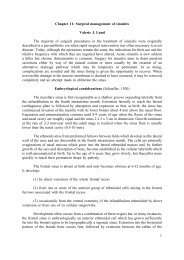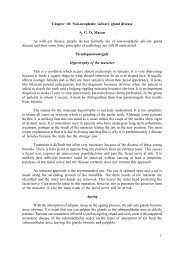73 The Plantar Reflex
73 The Plantar Reflex
73 The Plantar Reflex
You also want an ePaper? Increase the reach of your titles
YUMPU automatically turns print PDFs into web optimized ePapers that Google loves.
<strong>73</strong> <strong>The</strong> <strong>Plantar</strong> <strong>Reflex</strong><br />
H. KENNETH WALKER<br />
Definition<br />
Stroking the lateral part of the sole of the foot with a fairly<br />
sharp object produces plantar flexion of the big toe ; often<br />
there is also flexion and adduction of the other toes . This<br />
normal response is termed the flexor plantar reflex.<br />
In some patients, stroking the sole produces extension<br />
(dorsiflexion) of the big toe, often with extension and abduction<br />
("fanning") of the other toes . This abnormal response<br />
is termed the extensor plantar reflex, or Babinski reflex .<br />
Technique<br />
Place the patient in a supine position and tell him or her<br />
that you are going to scratch the foot, first gently and then<br />
more vigorously . Fixate the foot by grasping the ankle or<br />
medial surface with the examiner's hand that will be closest<br />
to the midline of the patient : examiner's left hand when<br />
the patient's left foot is being tested, and vice versa with the<br />
right foot . Begin with light stroking, using your finger ; then<br />
use a blunt object such as the point of a key . Finally, if no<br />
abnormal response has been obtained, take a tongue blade<br />
and break it in half longitudinally and use the sharp point .<br />
<strong>The</strong> reason for the graded stimuli is twofold : (1) Light touch,<br />
as with a finger, frequently obtains the reflex without causing<br />
a withdrawal response that on occasion makes interpretation<br />
of the response difficult ; (2) one cannot conclude<br />
the response is normal until a noxious stimulus is indeed<br />
used, since the reflex is a cutaneous nociceptive reflex .<br />
<strong>The</strong> first line to be stroked begins a few centimeters distal<br />
to the heel and is situated at the junction of the dorsal and<br />
plantar surfaces of the foot (Figure <strong>73</strong> .1) . <strong>The</strong> line extends<br />
to a point just behind the toes and then turns medially across<br />
the transverse arch of the foot . Stroke slowly, taking 5 or<br />
6 seconds to complete the motion . Do not dig into the sole,<br />
but stroke .<br />
Figure <strong>73</strong>.1<br />
Testing the plantar reflex .<br />
Successive lines are stroked, each about 1 cm medial to<br />
the preceding stroke, until the examiner is stroking the<br />
midline of the foot . <strong>The</strong> reason for beginning laterally is<br />
that in some cases the response is abnormal laterally and<br />
then becomes normal as the midline is approached . <strong>The</strong><br />
occurrence of the extensor response on any of these lines<br />
is abnormal, even if the response is flexor on another line<br />
of stroking. This variation relates to variability in the receptive<br />
field of the reflex, undoubtedly due to the extent<br />
of corticospinal involvement as well as individual differences<br />
.<br />
<strong>The</strong> reflex is normal if the abnormal response is not<br />
obtained from any of the stroke lines using all of the stimuli<br />
described .<br />
A good habit is to describe whatever response is obtained<br />
in addition to noting whether in your opinion the response<br />
is normal or abnormal .<br />
Basic Science<br />
<strong>The</strong> neurophysiology of this reflex has not been completely<br />
elucidated . <strong>The</strong> account given here follows the suggestions<br />
made by Kugelberg, Eklund, and Grimby (1960) and is the<br />
result of their electromyographic studies . Each area of the<br />
skin of the body appears to have a specific reflex response<br />
to noxious stimuli . <strong>The</strong> purpose of the reflex is to cause the<br />
withdrawal of the area of the skin from the stimulus . This<br />
reflex is mediated by the spinal cord, but influenced by<br />
higher centers . <strong>The</strong> area of skin from which the reflex can<br />
be obtained is known as the receptive field of the reflex .<br />
To be more specific, a noxious stimulus to the sole of the<br />
foot, which is the receptive field, causes immediate flexion<br />
of the toes, ankle, knee, and hip joints with attendant withdrawal<br />
of the foot from the stimulus . Remember your own<br />
experiences with this reflex, an example being stepping on<br />
a sharp object while barefoot . <strong>The</strong>re is an instant involuntary<br />
flexion of all joints with withdrawal . Another reflex<br />
in the normal individual is the great toe reflex : Stimulation<br />
of the ball of the toe, which is the receptive field, causes<br />
extension (dorsiflexion) of the toe with flexion at ankle,<br />
knee, and hip joints . <strong>The</strong> differences between these two<br />
reflexes are in the receptive fields and the fact that the great<br />
toe is flexed in one and extended in the other . <strong>The</strong> reason<br />
for the extension in the toe reflex is to remove the toe from<br />
the stimulus .<br />
<strong>The</strong> abnormal plantar reflex, or Babinski reflex, is the<br />
elicitation of toe extension from the "wrong" receptive field,<br />
that is, the sole of the foot . Thus a noxious stimulus to the<br />
sole of the foot produces extension of the great toe instead<br />
of the normal flexion response . <strong>The</strong> essential phenomenon<br />
appears to be recruitment of the extensor hallucus longus,<br />
with consequent overpowering of the toe flexors (Landau,<br />
1971) . <strong>The</strong> movements of the other joints remain the same .<br />
<strong>The</strong> corticospinal tract influences the segmental reflex<br />
369
370 IV. THE NEUROLOGIC SYSTEM<br />
in the spinal cord . When the corticospinal tract is not functioning<br />
properly, the result is that the receptive field of the<br />
normal toe extensor reflex enlarges at the expense of the<br />
receptive field for toe flexion . Toe extension is consequently<br />
elicited from what is normally the receptive field for toe<br />
flexion . <strong>The</strong> maintenance of territorial integrity of the receptive<br />
fields is apparently one way in which the cortex<br />
exerts its influence under normal conditions .<br />
Clinical Significance<br />
<strong>The</strong> plantar reflex is a nociceptive segmental spinal reflex<br />
that serves the purpose of protecting the sole of the foot .<br />
<strong>The</strong> clinical significance lies in the fact that the abnormal<br />
response reliably indicates metabolic or structural abnormality<br />
in the corticospinal system upstream from the segmental<br />
reflex . Thus the extensor reflex has been observed<br />
in structural lesions such as hemorrhage, brain and spinal<br />
cord tumors, and multiple sclerosis, and in abnormal metabolic<br />
states such as hypoglycemia, hypoxia, and anesthesia .<br />
<strong>The</strong>re is disagreement about whether the response is<br />
plantar flexion or dorsiflexion in the majority of newborns<br />
(Hogan and Milligan, 1971 ; Ross et al ., 1976) . In all cases,<br />
however, the response does become flexor by the sixth to<br />
twelfth month of life .<br />
On rare occasions the extensor reflex has been reported<br />
in individuals who were otherwise normal ; however, there<br />
is no long-term follow-up of these cases reported in the<br />
literature . In summary, there is widespread agreement<br />
among neurologists that an extensor plantar response about<br />
the sixth to twelfth month of life indicates structural or<br />
metabolic dysfunction of the corticospinal system .<br />
<strong>The</strong> receptive field for the extensor plantar response can<br />
be quite extensive. On occasion the extensor reflex has been<br />
elicited by stimulating as high as the face . Even in the same<br />
individual there is often shrinkage in the receptive field as<br />
time passes after the occurrence of the lesion .<br />
<strong>The</strong> reflex response is on occasion equivocal . For example,<br />
there may be flexion of the toes before extension .<br />
Table <strong>73</strong> .1<br />
Variants of the Babinski Sign<br />
Eponym<br />
Chaddock (1911)<br />
Bing (1915)<br />
Oppenheim (1902)<br />
Gordon (1904)<br />
Schaefer (1899)<br />
Technique<br />
<strong>The</strong> skin under and around the lateral<br />
malleolus is stroked in a circular fashion .<br />
<strong>The</strong> stimulus may also be carried<br />
forward from the heel to the small toe .<br />
<strong>The</strong> dorsum of the big toe is pricked with<br />
a pin . <strong>The</strong> big toe withdraws into the<br />
pin when abnormal, as opposed to being<br />
flexed away from the stimulus when<br />
normal. This sign and the Chaddock<br />
sign are perhaps the most reliable after<br />
the Babinski sign .<br />
<strong>The</strong> thumb and index finger apply heavy<br />
pressure to the anterior surface of the<br />
tibia, stroking down to the ankle .<br />
Compressing the calf muscles, or applying<br />
deep pressure to them .<br />
Pinching the Achilles tendon enough to<br />
cause pain .<br />
Landau has addressed very nicely this question of an initial<br />
flexor movement of the toe followed by extension :<br />
But even when the abnormal response is maximally<br />
developed, as in our illustrated case of paraplegia, early<br />
flexion may occur, especially with threshold stimulation .<br />
What these observations amount to practically is that<br />
competent clinical judgment of this peculiar behavior,<br />
God's gift to the neurologist, has more validity than an<br />
arbitrary rule concerning the initial direction of hallux<br />
movement . (Landau and Clare, 1959)<br />
On occasion, the reflex may be unequivocally flexor on<br />
one side and the toe remains neutral without movement on<br />
the other side . Under these circumstances the question is<br />
whether there is evidence of corticospinal tract dysfunction,<br />
and not whether the response is flexor or extensor .<br />
This question can often be answered by looking for other<br />
evidence of corticospinal dysfunction, such as repeating deep<br />
tendon reflexes . Table <strong>73</strong> .1 gives a number of other signs<br />
that indicate corticospinal dysfunction, just as the Babinski<br />
sign . Occasionally one of them may be positive when the<br />
Babinski is not present . Sometimes it is helpful to do two<br />
of them together, such as the Babinski and the Oppenheim,<br />
or the Babinski and the Gordon . <strong>The</strong> Babinski sign is the<br />
most reliable, and the one most likely to be present initially .<br />
Excellent discussions of these various signs may be found<br />
in DeJong (1979) and Van Gijn (1977) .<br />
References<br />
Babinski JF, in Wilkins RH, Brody IA, eds . Babinski's sign . Arch<br />
Neurol 1967 ; 17 :441-46 .<br />
Brain R, Wilkinson M . Observations on the extensor plantar reflex<br />
and its relationship to the functions of the pyramidal tract . Brain<br />
1959 ;82 :297-320 .<br />
Brodal A. Neurological anatomy in relation to clinical medicine .<br />
3rd ed. New York : Oxford University Press, 1981 .<br />
Dejong RN . <strong>The</strong> neurologic examination . 4th ed . New York : Harper<br />
& Row, 1979 ;451-63 .<br />
Dohrmann GJ, Nowack WJ . <strong>The</strong> upgoing great toe : optimal method<br />
of elicitation . Lancet 19<strong>73</strong> ;1 :339-41 .<br />
Estanol B . Temporal course of the threshold and size of the receptive<br />
field of the Babinski sign . J Neurol Neurosurg Psychiatry<br />
1983 ;46 :1055-57 .<br />
Fulton JF, Keller AD . <strong>The</strong> sign of Babinski. Springfield : Charles<br />
C Thomas, 1932 .<br />
Hogan GR, Milligan JE . <strong>The</strong> plantar reflex of the newborn . N Engl<br />
J Med 1971 ;285 :502-3 .<br />
Kugelberg E, Eklund K, Grimby L . An electromyographic study<br />
of the nociceptive reflexes of the lower limb : mechanism of the<br />
plantar responses . Brain 1960 ;83 :394-410 .<br />
Landau W. Clinical definition of the extensor plantar reflex (letter) .<br />
N Engl J Med 1971 ;285 :1149-50 .<br />
Landau WM, Clare MH . <strong>The</strong> plantar reflex in man with special<br />
reference to some conditions where the extensor response is<br />
unexpectedly absent . Brain 1959 ;82 :321-55 .<br />
Ross ED, Velez-Borras J, Rosman NP . <strong>The</strong> significance of the Babinski<br />
sign in the newborn : a reappraisal . Pediatrics 1976 ;57 :13-<br />
15 .<br />
VanGijn J . <strong>The</strong> plantar reflex . Rotterdam : Krips Repro-Meppel,<br />
1977 .<br />
Walshe F . <strong>The</strong> Babinski plantar response : its form and its physiological<br />
and pathological significance . Brain 1956 ;79 :529-56.




